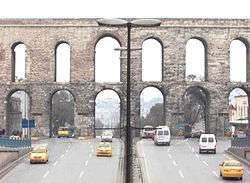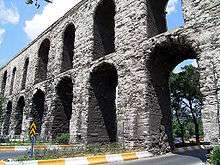Valens Aqueduct
| Valens Aqueduct | |
|---|---|
 Valens Aqueduct at Atatürk Bulvari seen from southwest | |
| Carries | Aqueduct to Constantinople |
| Locale | Istanbul, Turkey |
| Official name | Bozdoğan Kemeri |
| Characteristics | |
| Design | Arch bridge |
| Material | Stone, brick |
| Total length | Originally 971 m (3,186 ft) |
| Width | 7.75–8.24 m (25.4–27.0 ft) |
| Height | Ca. 29 m (95 ft) |
| Longest span | Ca. 4 m (13 ft) |
| History | |
| Construction end | 368 AD |

The Valens Aqueduct (Turkish: Bozdoğan Kemeri, meaning "Aqueduct of the Grey Falcon"; Ancient Greek: Ἀγωγὸς τοῦ ὕδατος, Agōgós tou hýdatos, meaning simply "aqueduct") is a Roman aqueduct which was the major water-providing system of the Eastern Roman capital of Constantinople (modern Istanbul, Turkey). Completed by Roman Emperor Valens in the late 4th century AD, it was maintained and used by the Byzantines and later the Ottomans, and remains one of the most important landmarks of the city.
Bridge section location
The most visible bridge section of the aqueduct stands in Istanbul, in the quarter of Fatih, and spans the valley between the hills occupied today by the Istanbul University and the Fatih Mosque. The surviving section is 921 metres long, about 50 metres less than the original length.[1] The Atatürk Bulvarı boulevard passes under its arches.
History
Roman period
The construction of a water supply system for the city (then still called Byzantium) had begun already under the Roman emperor Hadrian.[2] Under Constantine I, when the city was rebuilt and increased in size, the system needed to be greatly expanded to meet the needs of the rapidly growing population.[3]
The Valens aqueduct, which originally got its water from the slopes of the hills between Kağıthane and the Sea of Marmara,[4] was merely one of the terminal points of this new wide system of aqueducts and canals – which eventually reached over 250 kilometres (160 mi) in total length, the longest such system of Antiquity – that stretched throughout the hill-country of Thrace and provided the capital with water. Once in the city, the water was stored in three open reservoirs and over a hundred underground cisterns, such as the Basilica Cistern, with a combined capacity of over 1 million cubic meters.[5]
The exact date that construction on the aqueduct began is uncertain, but it was completed in 368 AD during the reign of Roman Emperor Valens, whose name it bears. The spectacular bridge section lay along the valley between the third and fourth hills of Constantinople, occupied respectively at that time by the Capitolium and the Church of the Holy Apostles.[6] According to tradition, the aqueduct bridge was built using the stones of the walls of Chalcedon, pulled down as punishment in 366 after the revolt of Procopius.[6] The structure was inaugurated in 373 by the urban prefect Clearchus, who commissioned a Nymphaeum Maius in the Forum of Theodosius, that was supplied with water from the aqueduct.[6]a[›]
After a severe drought in 382, Theodosius I built a new line (the Aquaeductus Theodosiacus), which took water from the north-eastern region known today as the “Belgrade Forest”.[3]
East Roman (Byzantine) period
Other works were executed under Theodosius II, who decided to distribute the water of the aqueduct exclusively to the Nymphaeum, the Baths of Zeuxippus and the Great Palace of Constantinople.[3] The aqueduct, possibly damaged by an earthquake, was restored under Emperor Justinian I, who connected it with the Cistern of the Basilica of Illusb[›] (identified today either with the Yerebatan or with the Binbirdirek (Turkish: Turkish): "thousand and one columns") cistern, and was repaired in 576 by Justin II, who built a separate pipe.[6][7]
The aqueduct was cut by the Avars during the siege of 626, and the water supply was reestablished only after the great drought of 758 by Emperor Constantine V.[6] The emperor had the whole water supply system repaired by a certain Patrikios, who used a large labour force coming from the whole of Greece and Anatolia.[6]
Other maintenance works were accomplished under Emperors Basil II (in 1019) and Romanos III Argyros.[4][8]
The last Byzantine emperor who took care of the aqueduct was Andronikos I Komnenos.[7] Neither during the Latin Empire nor during the Palaiologan period were any repair works executed, but by that time the population of the city had shrunk to about 40,000–50,000 inhabitants, so that the water supply was no longer a very important issue.[4] Nevertheless, according to Ruy Gonzáles de Clavijo, a Castilian diplomat who traveled to Constantinople en route to an embassy to Timur in 1403, the aqueduct was still functioning.[6]
Ottoman period
_-_Google_Art_Project.jpg)

After the fall of Constantinople (1453), Sultan Mehmet II repaired the whole water supply, which was then used to bring water to the imperial palaces of Eski Sarayi (the first palace, built on the third hill) and Topkapı Sarayi, and connected it with a new line coming from the northeast. The great earthquake of 1509 destroyed the arches near the Mosque of Şehzade, which was erected some time later. This gave rise to the popular legend that they were cut in order to allow a better view from the nearby mosque. The repairs to the water-supplying net continued under Beyazid II, who added a new line.[8]
Around the middle of the 16th century, Suleyman I rebuilt arches (now ogival) 47 up to 51 (counted from the west) near the Şehzade Mosque, and commissioned the Imperial Architect Mimar Sinan to add two more lines, coming from the Forest of Belgrade (Belgrad Ormanı).[4] The increased flow allowed the distribution of water to the Kιrkçeşme ("Forty Fountains") quarter, situated along the aqueduct on the Golden Horn side, and so called after the many fountains built there under Suleyman.[4]
Under Sultan Mustafa II, five arches (41–45) were restored, respecting the ancient form. An inscription in situ, dated 1696/97, commemorates the event.[8] His successor Ahmed III repaired again the distribution net.[8]
In 1912, a 50-meter-long part of the aqueduct near the Fatih Mosque was pulled down.[4] In the same period, a new modern Taksim ("distribution plant", lit. 'division') at the east end was erected.[4]
Description

The bridge section of the Aqueduct of Valens had a length of 971 metres (3,186 ft) and a maximum height of about 29 metres (63 metres above sea level) with a constant slope of 1:1000.[6] Arches 1–40 and 46–51 belong to the time of Valens, arches 41–45 to Mustafa II, and those between 52 and 56 to Suleyman I.[9] Arches 18–73 have a double order, the others a single order.[6][9]
Originally the structure ran perfectly straight, but during the construction of the Fatih Mosque – for unknown reasons – it was bent in that section.[10] The masonry is not regular, and uses a combination of ashlar blocks and bricks.[6] The first row of arches is built with well-squared stone blocks; the upper row is built with four to seven courses of stones alternated with a bed of smaller material (opus caementitium) clamped with iron cramps.[10] The width of the aqueduct bridge varies from 7.75 metres to 8.24 metres.[6] The pillars are 3.70 metres thick, and the arches of the lower order are 4 metres wide.[10] As a result of geophysical surveys performed in 2009, it is now known that pillars' foundations are approximately 5.4–6.0 m below the present-day surface.[11]
The water comes from two lines from the north-east and one coming from the north-west, which join together outside the walls, near the Adrianople Gate (Edirne Kapı).[1] Near the east end of the aqueduct there is a distribution plant, and another lies near Hagia Sophia. The water feeds the zone of the imperial palace.[10] The daily discharge in the 1950s amounted to 6,120 cubic metres (216,000 cu ft).[10] During Byzantine times, two roads important for the topography of medieval Constantinople crossed under the eastern section of the aqueduct.[10]
Notes
^ a: The Nymphaeum, which was called "abundant water" (δαψιλές ὔδωρ, dapsilés hýdor in Greek), was one of the four Nymphaea existing in the city in the first third of the 4th century. Its basin was still functioning in 1577.[12]
^ b: Illus was a magister militum, who played an important role under Emperors Leo I and Zeno. Justinian enlarged an already existing cistern built by Constantine, which was placed under the quadriporticus of the Basilica.[13]
References
- 1 2 Mamboury (1953), p. 196.
- ↑ Evans (1996), p. 30.
- 1 2 3 Mamboury (1953), p. 193.
- 1 2 3 4 5 6 7 Mamboury (1953), p. 202.
- ↑ Evans (1996), p. 31.
- 1 2 3 4 5 6 7 8 9 10 11 Müller-Wiener (1977), p. 273.
- 1 2 Mamboury (1953), p. 194.
- 1 2 3 4 Müller-Wiener (1977), p. 274.
- 1 2 Eyice (1955), p. 78.
- 1 2 3 4 5 6 Mamboury (1953), p. 203.
- ↑ "GPR Surveying of Valens Aqueduct". (In Turkish). Tespit Engineering. Retrieved 25 May 2013.
- ↑ Janin (1964), p. 194.
- ↑ Janin (1964), pp. 157, 173.
Sources
- Janin, Raymond (1964). Constantinople Byzantine (in French) (2 ed.). Paris: Institut Français d'Etudes Byzantines.
- Mamboury, Ernest (1953). The Tourists' Istanbul. Istanbul: Çituri Biraderler Basımevi.
- Eyice, Semavi (1955). Istanbul. Petite Guide a travers les Monuments Byzantins et Turcs (in French). Istanbul: Istanbul Matbaası.
- Gülersoy, Çelik (1976). A Guide to Istanbul. Istanbul: Istanbul Kitaplığı. OCLC 3849706.
- Müller-Wiener, Wolfgang (1977). Bildlexikon zur Topographie Istanbuls: Byzantion, Konstantinupolis, Istanbul bis zum Beginn d. 17 Jh (in German). Tübingen: Wasmuth. ISBN 978-3-8030-1022-3.
- Evans, J.A.S. (1996). The Age of Justinian: The Circumstances of Imperial Power. Routledge.
- Freely, John (2000). Blue Guide Istanbul. W. W. Norton & Company. ISBN 0-393-32014-6.
External links
| Wikimedia Commons has media related to Valens Aqueduct. |
- 3D reconstruction of the Aquaeduct of Valens at the Byzantium 1200 project
- Turkish Ministry of Culture - Water supply systems and cisterns of Constantinople
Coordinates: 41°00′57.4″N 28°57′20″E / 41.015944°N 28.95556°E
